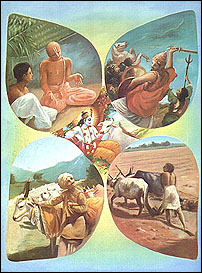Nowhere is caste better exemplified by degree of complexity and systematic operation than in India. The Indian term for caste is jati, which generally designates a group varying in size from a handful to many thousands. There are thousands of such jatis, and each has its distinctive rules, customs, and modes of government. The term varna (literally meaning "color") refers to the ancient and somewhat ideal fourfold division of Hindu society: (1) the Brahmans, the priestly and learned class; (2) the Kshatriyas, the warriors and rulers; (3) the Vaisyas, farmers and merchants; and (4) the Sudras, peasants and laborers. These divisions may have corresponded to what were formerly large, broad, undifferentiated social classes. Below the category of Sudras were the untouchables, or Panchamas (literally "fifth division"), who performed the most menial tasks.
Saturday, March 20, 2010
The Caste System in India
Posted by
Rupinder
at
2:21 AM
0
comments
![]()
India History
According to socio-historical theory, the caste system began with the arrival of the Aryans in India. The Aryans arrived in India around 500 B. C. (some claim a much earlier date). The fair skinned Aryans arrived in India from south Europe and north Asia. Before the Aryans there were other communities in India of other origins. Among them Negrito, Mongoloid, Austroloid and Dravidian. The Negrito have physical features similar to people of Africa. The Mongoloid have Chinese features. The Austroloids have features similar the aboriginals of Australia. The Dravidians originate from the Mediterranean and they were the largest community in India. When the Aryans arrived in India their main contact was with the Dravidians and the Austroloids. The Aryans disregarded the local cultures. They began conquering and taking control over regions in north India and at the same time pushed the local people southwards or towards the jungles and mountains in north India. The Aryans organized among themselves in three groups. The first group was of the warriors and they were called Rajayana, later they changed their name Rajayana to Kshatria. The second group was of the priests and they were called Brahmans. These two groups struggled politically for leadership among the Aryans. In this struggle the Brahmans got to be the leaders of the Aryan society. The third group was of the farmers and craftsmen and they were called Vaisia. The Aryans who conquered and took control over parts of north India subdued the locals and made them their servants. In this process the Vaisias who were the farmers and the craftsmen became the landlords and the businessmen of the society and the locals became the peasants and the craftsmen of the society.
Posted by
Rupinder
at
2:12 AM
0
comments
![]()
Caste System in India History
Posted by
Rupinder
at
1:38 AM
0
comments
![]()
Friday, March 19, 2010
Caste Politics in India
Posted by
Rupinder
at
9:06 PM
0
comments
![]()






